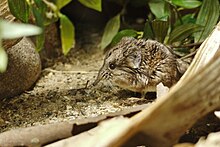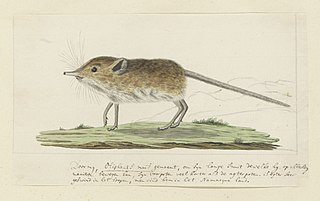297:
1257:
210:
44:
88:
63:
288:
behavior. Mate guarding is considered a predominant male trait in round-eared elephant shrews. This strategy is used to guard the female before and after heat to eliminate male competition, which makes male round-eared elephant shrews monogamous and more vulnerable to their surroundings as they spent
292:
Research was recently conducted to determine that elephant shrews are thought to have dichromatic color vision due to their ability to differentiate between blue/green colors and grey. However, there is no evidence to prove that the species can see red colors.
329:
Round-eared elephant shrews are omnivores with their diet mainly consisting of insects and supplemented with plants. During the winter, this species consumes less insects than they do during the summer due to a decrease in the insect population.
517:
Bernard, R. T. F., G. I. H. Kerley, T. Doubell and A. Davison 1996. Reproduction in the round-eared elephant shrew (Macroscelides proboscideus) in the southern Karoo, South Africa. Journal of
Zoology, London, 240
1315:
Lawes, M. J., and M. R. Perrin. “Risk-Sensitive
Foraging Behaviour of the Round-Eared Elephant Shrew (Macroscelides Proboscideus).” Behavioral Ecology and Sociobiology, vol. 37, no. 1,25 Feb. 1995, pp. 31–37.,
1138:
1203:
1335:
1298:
1112:
1151:
652:
493:
296:
1350:
1355:
1340:
476:
1291:
1177:
406:"Phylogeny and Taxonomy of the Round-Eared Sengis or Elephant-Shrews, Genus Macroscelides (Mammalia, Afrotheria, Macroscelidea)"
1195:
1156:
1038:
908:
899:
722:
87:
1284:
1190:
1060:
842:
794:
767:
740:
645:
24:
1256:
1208:
1360:
776:
1345:
984:
884:
875:
209:
758:
199:
280:
Elephant shrews are among only a handful of monogamous mammals, making them a model group for the study of
1000:
950:
638:
577:"Colour vision in sengis (Macroscelidea, Afrotheria, Mammalia): choice experiments indicate dichromatism"
1229:
1065:
818:
785:
182:
528:
Schubert, Melanie; Schradin, Carsten; Rödel, Heiko G.; Pillay, Neville; Ribble, David O. (2009-12-01).
497:
382:
1086:
1047:
959:
749:
417:
530:"Male mate guarding in a socially monogamous mammal, the round-eared sengi: on costs and trade-offs"
1052:
932:
851:
731:
305:
281:
52:
630:
596:
557:
321:
where the temperature ranges from 18°C to 6°C in the winter and 30°C to 22°C during the summer.
82:
1234:
1143:
43:
1216:
1169:
1073:
549:
472:
445:
1268:
464:
1221:
968:
588:
541:
435:
425:
377:
318:
274:
941:
404:
Dumbacher, J. P.; Rathbun, G. B.; Smit, H. A.; Eiseb, S. J. (2012). Steinke, Dirk (ed.).
421:
359:
662:
440:
405:
246:
149:
139:
1329:
1264:
1164:
833:
600:
368:
285:
159:
72:
67:
561:
1078:
713:
258:
430:
1182:
1125:
1032:
923:
1023:
809:
702:
592:
545:
553:
1099:
576:
529:
266:
262:
241:
to distinguish it from its sister species; formerly misleadingly named the "
99:
449:
625:
491:
California
Academy of Sciences. Elephant-shrews or Sengis: Macroscelidea.
1017:
696:
684:
250:
119:
1117:
254:
1317:
1130:
690:
678:
338:
The round-eared elephant shrew does not reproduce during the winter.
270:
129:
109:
994:
1104:
295:
1091:
998:
634:
353:
351:
1272:
261:. Its natural habitats are subtropical or tropical dry
249:(sengi) in the family Macroscelididae. It is found in
289:a majority of their time dedicated to this tactic.
1007:
921:
897:
873:
831:
807:
711:
383:10.2305/IUCN.UK.2015-2.RLTS.T45369602A45435551.en
469:The Mammals of the Southern African Sub-region
1292:
646:
467:. In Skinner, J. D.; Chimimba, C. T. (eds.).
317:The round-eared elephant shrew are native to
8:
1299:
1285:
995:
653:
639:
631:
471:. Cambridge University Press. p. 26.
208:
61:
42:
31:
439:
429:
381:
358:Rathbun, G.B.; Smit-Robinson, H. (2015).
1308:
347:
7:
1253:
1251:
1336:IUCN Red List least concern species
534:Behavioral Ecology and Sociobiology
369:IUCN Red List of Threatened Species
284:. They have been studied for their
1318:https://doi.org/10.1007/bf00173896
1271:. You can help Knowledge (XXG) by
843:Namib round-eared elephant shrew (
14:
1255:
239:Karoo round-eared elephant shrew
86:
909:North African elephant shrew (
723:Short-snouted elephant shrew (
575:Thus, Patricia (16 Sep 2020).
1:
795:Western rock elephant shrew (
768:Eastern rock elephant shrew (
741:Dusky-footed elephant shrew (
861:Round-eared elephant shrew (
852:Etendeka round-eared sengi (
431:10.1371/journal.pone.0032410
334:Reproduction and life cycles
300:Round-eared elephant shrew (
269:, and hot deserts. They eat
777:Karoo rock elephant shrew (
302:Macroscelides proboscideus)
273:, shoots, and roots. Their
25:Macroscelides flavicaudatus
1377:
1351:Mammals of Southern Africa
1250:
1053:Macroscelides_proboscideus
1039:Macroscelides proboscideus
1009:Macroscelides proboscideus
885:Four-toed elephant shrew (
362:Macroscelides proboscideus
243:short-eared elephant shrew
230:Macroscelides proboscideus
225:round-eared elephant shrew
192:Macroscelides proboscideus
36:Macroscelides proboscideus
19:For the former subspecies
18:
1356:Taxa named by George Shaw
1341:Mammals described in 1800
981:
759:Bushveld elephant shrew (
673:
593:10.1163/1568539x-bja10039
546:10.1007/s00265-009-0842-2
216:
207:
188:
181:
83:Scientific classification
81:
59:
50:
41:
34:
951:Black and rufous sengi (
376:: e.T45369602A45435551.
819:Somali elephant shrew (
786:Rufous elephant shrew (
779:Elephantulus pilicaudus
463:Rathbun, G. H. (2005).
1267:-related article is a
750:Dusky elephant shrew (
309:
1230:Paleobiology Database
933:Golden-rumped sengi (
732:Cape elephant shrew (
465:"Order Macroscelidea"
299:
587:(14–15): 1127–1151.
245:"), is a species of
174:M. proboscideus
960:Stuhlmann's sengi (
626:Photos at Biolib.cz
422:2012PLoSO...732410D
306:Robert Jacob Gordon
53:Conservation status
21:M. p. flavicaudatus
969:Grey-faced sengi (
310:
304:, as described by
1280:
1279:
1245:
1244:
1217:Open Tree of Life
1001:Taxon identifiers
992:
991:
942:Chequered sengi (
725:E. brachyrhynchus
666:
665:(elephant shrews)
494:"Elephant-Shrews"
325:Foraging and diet
235:round-eared sengi
221:
220:
217:Geographic range
76:
16:Species of mammal
1368:
1361:Afrotheria stubs
1321:
1313:
1301:
1294:
1287:
1259:
1252:
1238:
1237:
1225:
1224:
1212:
1211:
1199:
1198:
1186:
1185:
1173:
1172:
1160:
1159:
1147:
1146:
1134:
1133:
1121:
1120:
1108:
1107:
1095:
1094:
1082:
1081:
1069:
1068:
1056:
1055:
1043:
1042:
1041:
1028:
1027:
1026:
996:
887:P. tetradactylus
845:M. flavicaudatus
664:
655:
648:
641:
632:
611:
610:
608:
607:
572:
566:
565:
525:
519:
515:
509:
508:
506:
505:
496:. Archived from
489:
483:
482:
460:
454:
453:
443:
433:
401:
395:
394:
392:
390:
385:
355:
319:Southeast Africa
275:gestation period
212:
194:
91:
90:
70:
65:
64:
46:
32:
1376:
1375:
1371:
1370:
1369:
1367:
1366:
1365:
1346:Elephant shrews
1326:
1325:
1324:
1314:
1310:
1306:
1305:
1248:
1246:
1241:
1233:
1228:
1220:
1215:
1207:
1202:
1194:
1189:
1181:
1176:
1168:
1163:
1155:
1150:
1142:
1137:
1129:
1124:
1116:
1111:
1103:
1098:
1090:
1085:
1077:
1072:
1064:
1059:
1051:
1046:
1037:
1036:
1031:
1022:
1021:
1016:
1003:
993:
988:
977:
971:R. udzungwensis
917:
893:
869:
863:M. proboscideus
827:
803:
707:
669:
659:
622:
615:
614:
605:
603:
574:
573:
569:
527:
526:
522:
516:
512:
503:
501:
492:
490:
486:
479:
462:
461:
457:
403:
402:
398:
388:
386:
357:
356:
349:
344:
336:
327:
315:
203:
196:
190:
177:
150:Macroscelididae
85:
77:
66:
62:
55:
28:
17:
12:
11:
5:
1374:
1372:
1364:
1363:
1358:
1353:
1348:
1343:
1338:
1328:
1327:
1323:
1322:
1307:
1304:
1303:
1296:
1289:
1281:
1278:
1277:
1260:
1243:
1242:
1240:
1239:
1226:
1213:
1200:
1187:
1174:
1161:
1148:
1135:
1122:
1109:
1096:
1083:
1070:
1057:
1044:
1029:
1013:
1011:
1005:
1004:
999:
990:
989:
982:
979:
978:
976:
975:
966:
957:
948:
939:
935:R. chrysopygus
929:
927:
919:
918:
916:
915:
905:
903:
895:
894:
892:
891:
881:
879:
871:
870:
868:
867:
858:
849:
839:
837:
829:
828:
826:
825:
815:
813:
805:
804:
802:
801:
792:
783:
774:
765:
756:
747:
738:
729:
719:
717:
709:
708:
706:
705:
699:
693:
687:
681:
674:
671:
670:
663:Macroscelidea
660:
658:
657:
650:
643:
635:
629:
628:
621:
620:External links
618:
613:
612:
567:
540:(2): 257–264.
520:
510:
484:
478:978-0521844185
477:
455:
396:
346:
345:
343:
340:
335:
332:
326:
323:
314:
311:
247:elephant shrew
219:
218:
214:
213:
205:
204:
197:
186:
185:
179:
178:
171:
169:
165:
164:
157:
153:
152:
147:
143:
142:
137:
133:
132:
127:
123:
122:
117:
113:
112:
107:
103:
102:
97:
93:
92:
79:
78:
60:
57:
56:
51:
48:
47:
39:
38:
15:
13:
10:
9:
6:
4:
3:
2:
1373:
1362:
1359:
1357:
1354:
1352:
1349:
1347:
1344:
1342:
1339:
1337:
1334:
1333:
1331:
1319:
1312:
1309:
1302:
1297:
1295:
1290:
1288:
1283:
1282:
1276:
1274:
1270:
1266:
1265:Macroscelidea
1261:
1258:
1254:
1249:
1236:
1231:
1227:
1223:
1218:
1214:
1210:
1205:
1201:
1197:
1192:
1188:
1184:
1179:
1175:
1171:
1166:
1162:
1158:
1153:
1149:
1145:
1140:
1136:
1132:
1127:
1123:
1119:
1114:
1110:
1106:
1101:
1097:
1093:
1088:
1084:
1080:
1075:
1071:
1067:
1062:
1058:
1054:
1049:
1045:
1040:
1034:
1030:
1025:
1019:
1015:
1014:
1012:
1010:
1006:
1002:
997:
987:
986:
980:
974:
972:
967:
965:
963:
962:R. stuhlmanni
958:
956:
954:
949:
947:
945:
940:
938:
936:
931:
930:
928:
926:
925:
920:
914:
912:
907:
906:
904:
902:
901:
900:Petrosaltator
896:
890:
888:
883:
882:
880:
878:
877:
872:
866:
864:
859:
857:
855:
850:
848:
846:
841:
840:
838:
836:
835:
834:Macroscelides
830:
824:
822:
817:
816:
814:
812:
811:
806:
800:
798:
793:
791:
789:
784:
782:
780:
775:
773:
771:
766:
764:
762:
757:
755:
753:
748:
746:
744:
739:
737:
735:
730:
728:
726:
721:
720:
718:
716:
715:
710:
704:
700:
698:
694:
692:
688:
686:
682:
680:
676:
675:
672:
667:
656:
651:
649:
644:
642:
637:
636:
633:
627:
624:
623:
619:
617:
602:
598:
594:
590:
586:
582:
578:
571:
568:
563:
559:
555:
551:
547:
543:
539:
535:
531:
524:
521:
514:
511:
500:on 2008-07-23
499:
495:
488:
485:
480:
474:
470:
466:
459:
456:
451:
447:
442:
437:
432:
427:
423:
419:
416:(3): e32410.
415:
411:
407:
400:
397:
384:
379:
375:
371:
370:
365:
363:
354:
352:
348:
341:
339:
333:
331:
324:
322:
320:
312:
308:in 1779–1780.
307:
303:
298:
294:
290:
287:
286:mate guarding
283:
278:
276:
272:
268:
264:
260:
256:
252:
248:
244:
240:
236:
232:
231:
226:
215:
211:
206:
201:
195:
193:
187:
184:
183:Binomial name
180:
176:
175:
170:
167:
166:
163:
162:
161:Macroscelides
158:
155:
154:
151:
148:
145:
144:
141:
140:Macroscelidea
138:
135:
134:
131:
128:
125:
124:
121:
118:
115:
114:
111:
108:
105:
104:
101:
98:
95:
94:
89:
84:
80:
74:
69:
68:Least Concern
58:
54:
49:
45:
40:
37:
33:
30:
26:
22:
1311:
1273:expanding it
1262:
1247:
1008:
983:
970:
961:
952:
943:
934:
922:
910:
898:
886:
874:
862:
860:
853:
844:
832:
820:
808:
797:E. rupestris
796:
788:E. rufescens
787:
778:
769:
760:
751:
742:
733:
724:
714:Elephantulus
712:
616:
604:. Retrieved
584:
580:
570:
537:
533:
523:
513:
502:. Retrieved
498:the original
487:
468:
458:
413:
409:
399:
387:. Retrieved
373:
367:
361:
337:
328:
316:
301:
291:
279:
277:is 56 days.
259:South Africa
242:
238:
237:(called the
234:
229:
228:
224:
222:
191:
189:
173:
172:
160:
35:
29:
20:
1126:iNaturalist
1033:Wikispecies
924:Rhynchocyon
876:Petrodromus
821:G. revoilii
743:E. fuscipes
734:E. edwardii
701:Superorder
695:Infraclass
389:11 November
1330:Categories
953:R. petersi
810:Galegeeska
703:Afrotheria
606:2021-12-05
504:2008-07-08
342:References
944:R. cirnei
911:P. rozeti
770:E. myurus
761:E. intufi
752:E. fuscus
601:224945580
581:Behaviour
554:1432-0762
267:grassland
263:shrubland
168:Species:
106:Kingdom:
100:Eukaryota
1196:11200023
1170:45369602
1144:11089356
1024:Q1130566
1018:Wikidata
985:Category
854:M. micus
697:Eutheria
691:Mammalia
685:Chordata
679:Animalia
677:Kingdom
562:44029280
518:233-243.
450:22479325
410:PLOS ONE
282:monogamy
251:Botswana
146:Family:
130:Mammalia
120:Chordata
116:Phylum:
110:Animalia
96:Domain:
73:IUCN 3.1
1183:1000457
1118:2440869
683:Phylum
668:species
661:Extant
441:3314003
418:Bibcode
313:Habitat
271:insects
255:Namibia
202:, 1800)
156:Genus:
136:Order:
126:Class:
71: (
1235:432157
1222:180378
1157:584922
1105:MAKRPR
1092:326395
689:Class
599:
560:
552:
475:
448:
438:
265:, and
257:, and
23:, see
1263:This
1209:29082
1139:IRMNG
1131:43228
1079:6R3ZG
1066:26225
597:S2CID
558:S2CID
233:) or
1269:stub
1204:NCBI
1165:IUCN
1152:ITIS
1113:GBIF
1100:EPPO
1061:BOLD
550:ISSN
473:ISBN
446:PMID
391:2021
374:2015
223:The
200:Shaw
1191:MSW
1178:MDD
1087:EoL
1074:CoL
1048:ADW
589:doi
585:157
542:doi
436:PMC
426:doi
378:doi
1332::
1232::
1219::
1206::
1193::
1180::
1167::
1154::
1141::
1128::
1115::
1102::
1089::
1076::
1063::
1050::
1035::
1020::
595:.
583:.
579:.
556:.
548:.
538:64
536:.
532:.
444:.
434:.
424:.
412:.
408:.
372:.
366:.
350:^
253:,
1320:.
1300:e
1293:t
1286:v
1275:.
973:)
964:)
955:)
946:)
937:)
913:)
889:)
865:)
856:)
847:)
823:)
799:)
790:)
781:)
772:)
763:)
754:)
745:)
736:)
727:)
654:e
647:t
640:v
609:.
591::
564:.
544::
507:.
481:.
452:.
428::
420::
414:7
393:.
380::
364:"
360:"
227:(
198:(
75:)
27:.
Text is available under the Creative Commons Attribution-ShareAlike License. Additional terms may apply.


